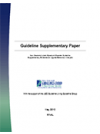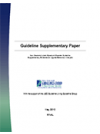This supplementary paper to the New Zealand Autism Spectrum Disorder Guideline considers the use of applied behaviour analysis (ABA).
New Zealand Autism Spectrum Disorder Guideline: Supplementary evidence on applied behaviour analysis
The supplementary paper was informed by three reviews. Two are separate technical/systematic reviews produced by the New Zealand Guidelines Group, and by a consortium of New Zealand academics with expertise in ABA. A third is an updated synthesis of that material and more recently published systematic reviews;
- The Effectiveness of Applied Behaviour Analysis Interventions for People with Autism Spectrum Disorder
- Technical Review of Published Research on Applied Behaviour Analysis Interventions for People with Autism Spectrum Disorder
- The Effectiveness of Applied Behaviour Analysis Interventions for People with Autism Spectrum Disorder: An update of secondary literature.
Purpose
The objective of this update is to critically appraise secondary research evidence published since December 2007 relating to the effectiveness of interventions and strategies grounded in the principles of applied behaviour analysis for people with autism spectrum disorder. ABA-based interventions can be defined as ‘those in which the principles of learning theory are applied in a systematic and measurable manner to increase, reduce, maintain and/or generalise target behaviours’ (Ministries of Health and Education, 2007).
Well-established principles and techniques of ABA include;
- reinforcement
- shaping
- chaining
- fading
- response and stimulus prompting
- discrimination training
- programming
- functional assessment (Broadstock & Lethaby, 2008).
The clinical question employed for this update of secondary literature was that used for the parallel technical reviews (Ministries of Health and Education, 2007): To what extent are interventions and strategies based on the principles of applied behaviour analysis effective in leading to the following outcomes for people with autism spectrum disorders:
- social development and relating to others
- development of cognitive (thinking) skills
- development of functional and spontaneous communication which is used in natural environments
- engagement and flexibility in developmentally appropriate tasks and play and later engagement in vocational activities
- development of fine and gross motor skills
- prevention of challenging behaviours and substitution with more appropriate and conventional behaviours
- development of independent organisational skills and other behaviours
- generalisation of abilities across multiple natural environments outside the treatment setting
- maintenance of effects after conclusion of intervention
- improvement in behaviours considered non-core ASD behaviours, such as sleep disturbance, self mutilation, aggression, attention and concentration problems.
Methodology
A systematic method of literature searching, selection and appraisal was employed in the preparation of this report, consistent with New Zealand Guidelines Group (NZGG) review processes (Broadstock & Lethaby, 2008).
The search was limited to articles published in the English language between January 1 2008 and August 6 2009 (when the search was conducted). Sources included general bibliographic databases (Medline, PsychINFO, EMBASE, CINAHL, ERIC, Cochrane Library) as well as various health technology assessment/guideline databases, and cross-checking of references from retrieved references.
Selection criteria were based on those used for the NZGG technical review (Broadstock & Lethaby, 2008), modified to solely identify on secondary studies. Studies were included if they:
- were secondary research (systematic reviews and meta-analyses)
- were published on or after January 1st 2008
- had a clear review question
- used at least two searching sources and reported on studies: of eligible interventions (studies which evaluated interventions which were predominantly based on the principles of applied behaviour analysis)
- considering comparators including usual care, another intervention or application of interventions
- considering individuals with a diagnosis of autism spectrum disorder or where results are reported separately for this group. Research papers were excluded if they:
- were non-systematic reviews, correspondence, editorials, expert opinion articles, comments, case reports, book chapters, articles published only in abstract form, conference proceedings, news items, unpublished work
- were primary studies (except where reported in included systematic reviews
- did not provide separate analyses/syntheses of results for eligible interventions and eligible population were not deemed appropriate to the research question or nature of review, including those reporting on outcomes solely relating to safety; the acceptability of, or ethical, economic or legal considerations relating to ABA; or the impact on persons other than those diagnosed with ASD.


